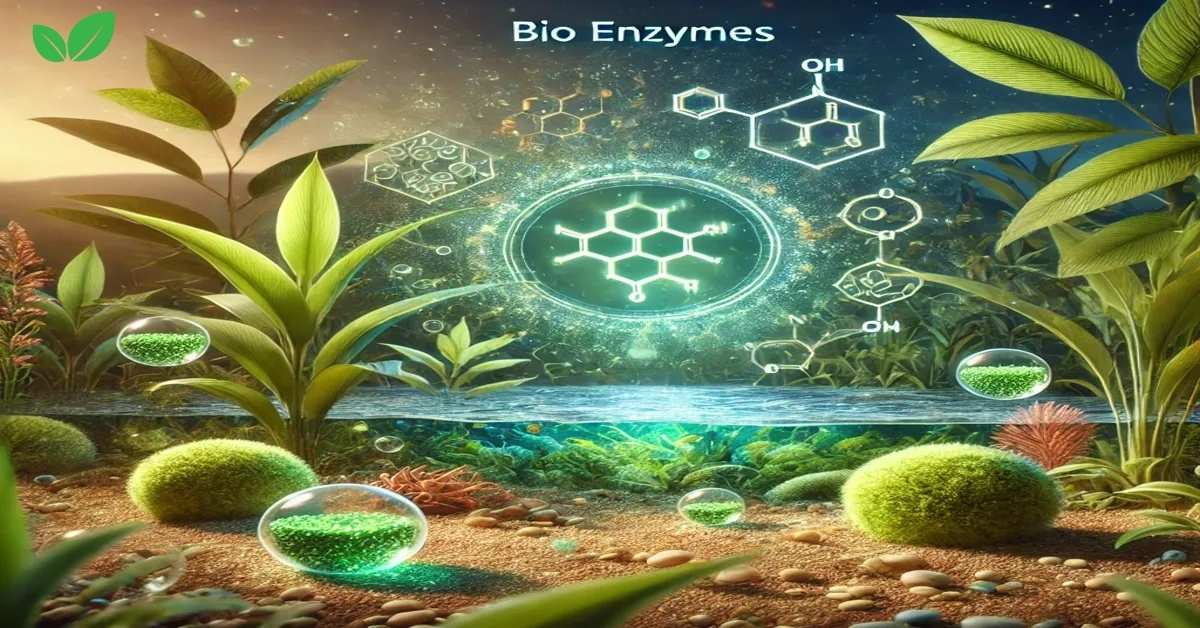Bio enzymes are organic solutions produced through the fermentation of organic waste such as fruit and vegetable peels, sugar, and water. These enzymes, primarily composed of proteins, play a crucial role in environmental sustainability, offering a natural, eco-friendly alternative to chemical cleaners and fertilizers. They have gained significant attention in recent years for their applications in waste management, pollution reduction, agriculture, and more. This article delves into the ecological niche of bio enzymes, including their production process, functions, benefits, and role in promoting sustainable practices.
1. Understanding Bio Enzymes
Bio enzymes are produced through a fermentation process that transforms organic waste into a multi-purpose, bioactive liquid. They contain enzymes like protease, amylase, and lipase, which break down proteins, starches, and fats, respectively. This enzymatic activity makes them versatile and effective in a range of applications, from cleaning surfaces to improving soil health.
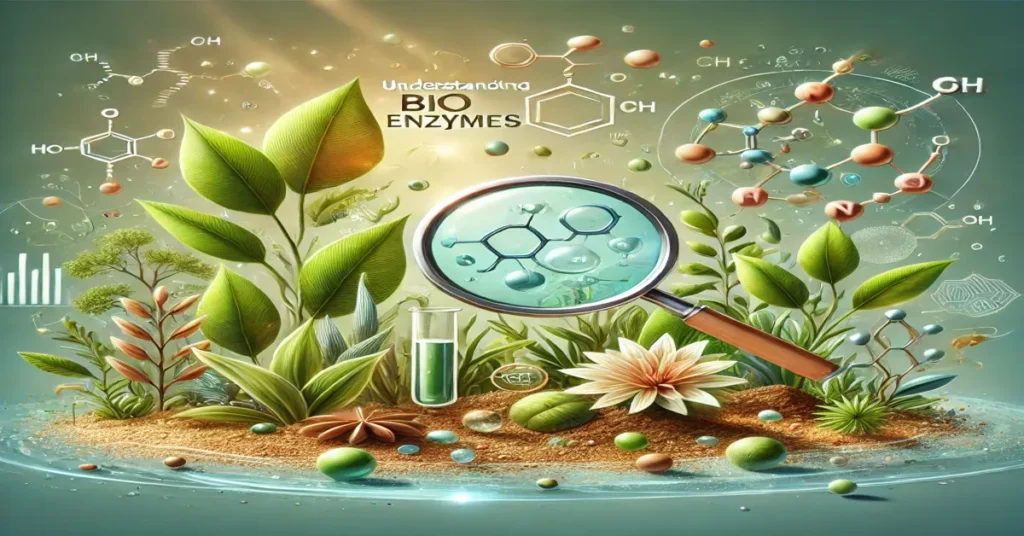
1.1. The Composition of Bio Enzymes
- Enzymes: The primary active ingredients in bio enzymes are proteins that catalyze chemical reactions. These enzymes can decompose organic matter, aiding in processes like digestion, cleaning, and breaking down pollutants.
- Microorganisms: During the fermentation process, beneficial microorganisms such as lactic acid bacteria and yeasts play a role in breaking down organic matter. These microorganisms enhance the effectiveness of enzymes by producing additional enzymes.
- Organic Acids: Bio enzymes also contain organic acids like citric and lactic acids, which have natural cleaning and preservative properties. These acids contribute to the breakdown of complex organic materials and help to neutralize odors.
1.2. How Bio Enzymes Are Made
The process of making bio enzymes is simple and accessible:
- Ingredients: The basic ingredients for enzyme production include organic waste (such as fruit peels), sugar (jaggery or molasses), and water. The typical ratio is 3:1:10, with three parts organic waste, one part sugar, and ten parts water.
- Fermentation Process: The ingredients are mixed and left to ferment for about three months. During this time, microorganisms break down the organic waste, producing enzymes and organic acids. The mixture needs to be stirred occasionally to release gases formed during fermentation.
- Final Product: After fermentation, the liquid is filtered to remove solid residues, resulting in a enzyme solution that is ready for various uses.
2. The Environmental Role and Applications of Bio Enzymes
Bio enzymes serve multiple ecological functions, helping to reduce pollution, manage waste, and improve agricultural productivity. Their versatility allows them to replace chemical-based products, reducing environmental damage.
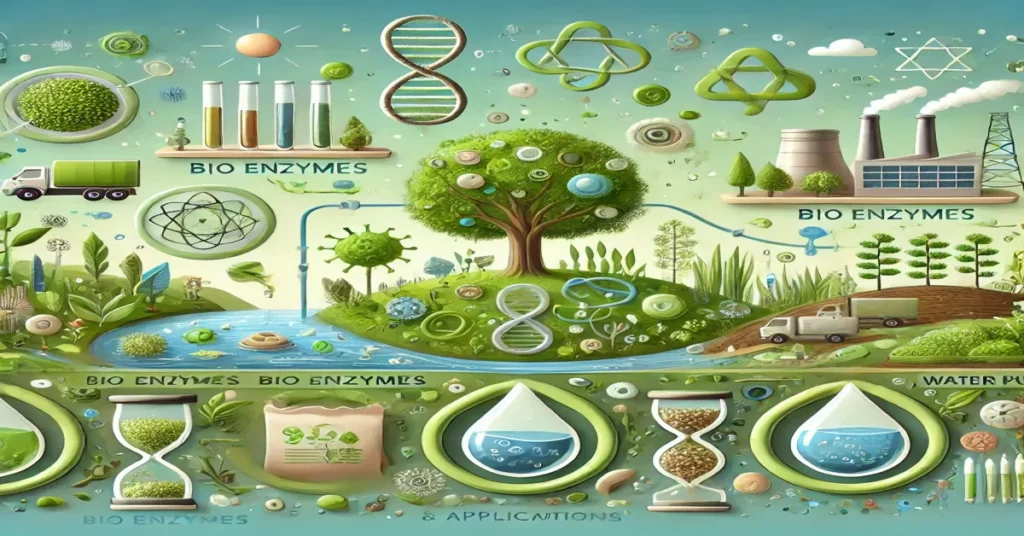
2.1. Bio Enzymes in Waste Management
Bio enzymes are particularly valuable in managing organic waste and reducing the environmental impact of waste disposal:
- Decomposition of Organic Waste: Bio enzymes accelerate the breakdown of organic matter in composting processes, turning waste into valuable compost more efficiently. This not only reduces the volume of waste sent to landfills but also helps produce nutrient-rich compost for soil.
- Odor Control: The enzymes and organic acids in enzymes help neutralize unpleasant odors from decomposing waste. This makes them useful in waste treatment facilities, garbage bins, and septic systems, where controlling foul odors is essential.
- Biodegradation of Pollutants: Bio enzymes can aid in the biodegradation of organic pollutants in wastewater treatment. They break down harmful substances, making them less toxic and easier to remove from water. This application is particularly relevant in treating industrial effluents and agricultural runoff.
2.2. Bio Enzymes as Eco-Friendly Cleaners
One of the most popular uses of bio enzymes is as a natural cleaning agent:
- Household Cleaning: Bio enzyme solutions can replace chemical-based detergents and cleaners. Their enzymatic activity effectively breaks down grease, grime, and organic stains on surfaces like floors, kitchen counters, and bathrooms. Unlike chemical cleaners, enzymes are biodegradable and do not release harmful residues into the environment.
- Industrial Cleaning: In industrial settings, enzymes are used to clean machinery, pipelines, and tanks. They are particularly effective in removing biofilms, which can form in water systems and machinery. By breaking down organic deposits, enzymes help maintain the efficiency of industrial equipment without the use of harsh chemicals.
- Textile and Laundry: Bio enzymes are also used in laundry detergents, where enzymes like protease and lipase break down protein- and fat-based stains. This reduces the need for synthetic surfactants, making laundry practices more sustainable.
2.3. Agricultural Applications of Bio Enzymes
In agriculture, bio enzymes are increasingly being used as bio-fertilizers and soil conditioners:
- Soil Health Improvement: When applied to soil, bio enzymes enhance microbial activity, improving soil structure and nutrient availability. They help decompose organic matter in the soil, releasing essential nutrients like nitrogen, phosphorus, and potassium.
- Pest and Disease Control: Bio enzyme sprays can act as natural pest repellents. The enzymes break down the exoskeletons of certain insects and pathogens, reducing the incidence of pests and diseases without harming beneficial insects like bees and ladybugs.
- Water Retention: Bio enzymes improve the water retention capacity of soil, which is crucial in regions prone to drought. They enhance soil porosity, allowing better infiltration and reducing water runoff, thus promoting sustainable water use in agriculture.
3. Ecological Benefits of Bio Enzymes
The use of enzymes provides numerous ecological benefits, from reducing environmental pollution to promoting sustainable waste management practices.
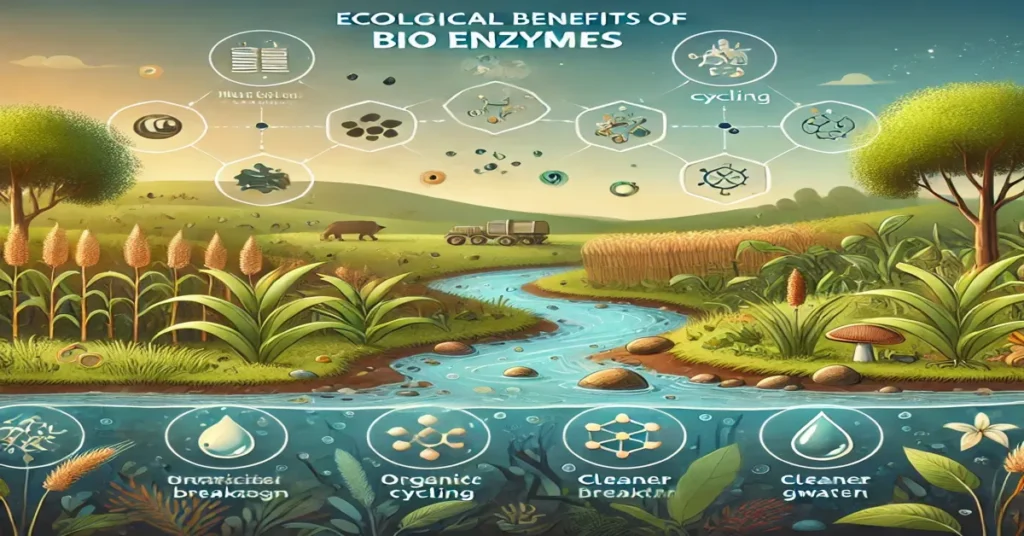
3.1. Reducing Chemical Pollution
Bio enzymes offer a natural alternative to chemical-based products, thereby reducing the environmental impact of harmful substances:
- Lower Toxicity: Unlike synthetic chemicals, bio enzymes are biodegradable and do not persist in the environment. They break down into harmless byproducts, minimizing their ecological footprint.
- Reduction of Chemical Runoff: In agriculture, replacing chemical fertilizers with enzyme solutions can significantly reduce the runoff of harmful chemicals into waterways. This prevents issues like algal blooms, which can devastate aquatic ecosystems by depleting oxygen levels in water bodies.
3.2. Supporting Circular Economy Principles
Bio enzymes align with the principles of a circular economy by transforming organic waste into valuable resources:
- Waste to Resource: The production of enzymes utilizes organic waste that would otherwise end up in landfills. By converting food waste into useful products, enzymes help close the loop in waste management, reducing the overall environmental burden.
- Resource Efficiency: Using enzymes in industrial processes can lead to greater resource efficiency by reducing the need for water and chemical inputs. This is particularly important in industries like food processing, textiles, and water treatment, where minimizing resource use is a key sustainability goal.
3.3. Enhancing Biodiversity and Soil Health
Bio enzymes contribute to the health of ecosystems, particularly in soil environments:
- Soil Biodiversity: The use of bio enzymes promotes the growth of beneficial soil microorganisms, which play a crucial role in nutrient cycling and soil fertility. A healthy microbial community in the soil supports plant growth and resilience to environmental stressors.
- Reducing Soil Erosion: By improving soil structure and water retention, enzymes help prevent soil erosion. This is especially valuable in areas where soil degradation and erosion pose significant challenges to agriculture and ecosystem stability.
4. Challenges in the Adoption of Bio Enzymes
While bioenzymes offer many ecological benefits, their widespread adoption faces several challenges, ranging from production scalability to awareness among potential users.
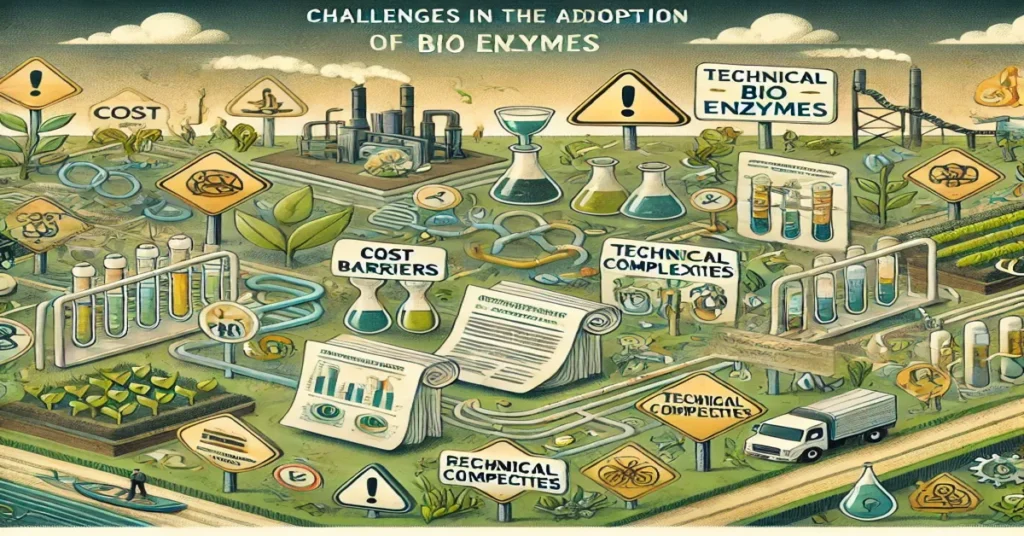
4.1. Production Challenges
- Consistency and Quality Control: Producing enzymes at a consistent quality can be challenging, especially in small-scale, home-based production setups. The fermentation process is sensitive to temperature, pH, and the quality of raw materials, which can affect the potency of the final product.
- Scalability: Scaling up bio enzyme production for industrial use requires significant investment in infrastructure and expertise. Unlike chemical cleaners and fertilizers, bio enzymes require a more controlled fermentation process, which can be a barrier for large-scale adoption.
4.2. Awareness and Education
- Lack of Awareness: Many consumers and businesses are not yet aware of the benefits of enzymes, or they may lack knowledge on how to use them effectively. Educating users about the proper production, storage, and application of enzymes is crucial for increasing their adoption.
- Resistance to Change: In many industrial sectors, there is a reluctance to switch from conventional chemical products to enzyme-based solutions. This resistance often stems from concerns about cost, effectiveness, and the time required for enzymes to take effect compared to faster-acting chemical alternatives.
4.3. Market Competition
- Competing with Chemical Products: Bio enzymes face competition from well-established chemical cleaning agents and fertilizers, which are often cheaper and more readily available. While enzymes offer long-term environmental benefits, their initial costs can be a deterrent for businesses and consumers focused on short-term financial savings.
- Regulatory Hurdles: In some regions, the regulatory framework for bio-based products like enzymes is still underdeveloped. This can limit the commercialization of bio enzymes, as companies may face challenges in getting their products approved for use in specific industries.
5. Promoting the Use of Bio Enzymes for a Sustainable Future
Despite the challenges, several strategies can promote the use of bio enzymes and integrate them into everyday practices, contributing to environmental sustainability.

5.1. Community-Based Initiatives
- Workshops and Training: Local workshops can teach communities how to produce bio-enzymes at home using kitchen waste. This not only reduces household waste but also empowers individuals to adopt sustainable cleaning and gardening practices.
- Collaborative Projects: Partnerships between environmental NGOs, schools, and community groups can promote bio-enzyme production on a larger scale, providing communities with access to eco-friendly solutions for waste management and cleaning.
5.2. Government and Industry Support
- Incentives for Green Technologies: Governments can play a crucial role by offering incentives and subsidies for industries that adopt bioenzyme technology. This can include grants for research and development, tax breaks for eco-friendly practices, and support for scaling up production facilities.
- Regulation and Standards: Establishing clear standards for the production and use of enzymes can ensure quality control and build consumer trust. Certification schemes can help distinguish genuine, high-quality bio-enzyme products from less effective alternatives.
5.3. Research and Development
- Improving Efficiency: Ongoing research into optimizing fermentation conditions and enhancing enzyme activity can make enzymes more competitive with chemical alternatives. Innovations like genetically engineered microorganisms could lead to more potent enzyme solutions that act faster and are effective at lower concentrations.
- Expanding Applications: Exploring new applications for bio enzymes in fields like bioremediation, biofuel production, and aquaculture can expand their market potential and encourage further investment in this technology.
Conclusion
Bio enzymes occupy a unique ecological niche as natural, sustainable alternatives to chemical products in various sectors, including waste management, cleaning, and agriculture. Their ability to decompose organic matter, enhance soil health, and reduce pollution makes them a valuable tool in the fight against environmental degradation. However, for bio enzymes to reach their full potential, efforts are needed to overcome challenges related to production, awareness, and market acceptance.
By promoting the use of enzymes through community initiatives, government support, and research, we can harness their power to build a more sustainable and eco-friendly future. As a product that transforms waste into a valuable resource, bio enzymes embody the principles of a circular economy, helping to reduce our ecological footprint and promote a healthier planet.
Read More: Secondary Containment Over Geotextile: An Environmental and Industrial Overview

